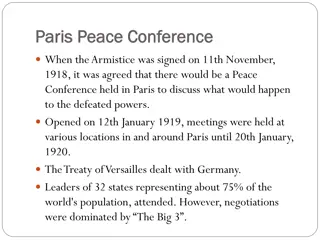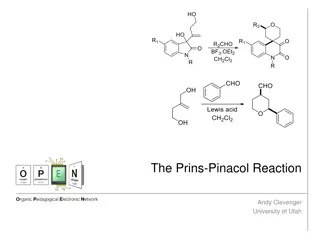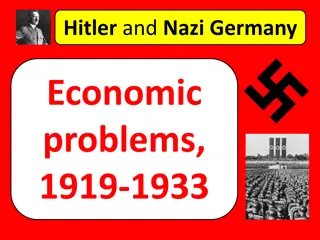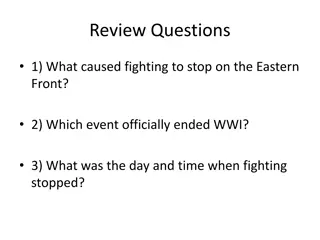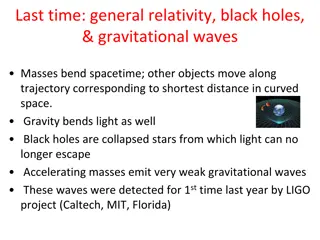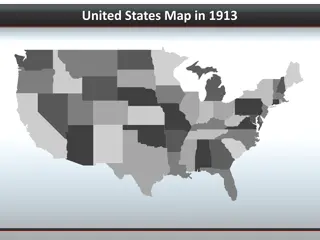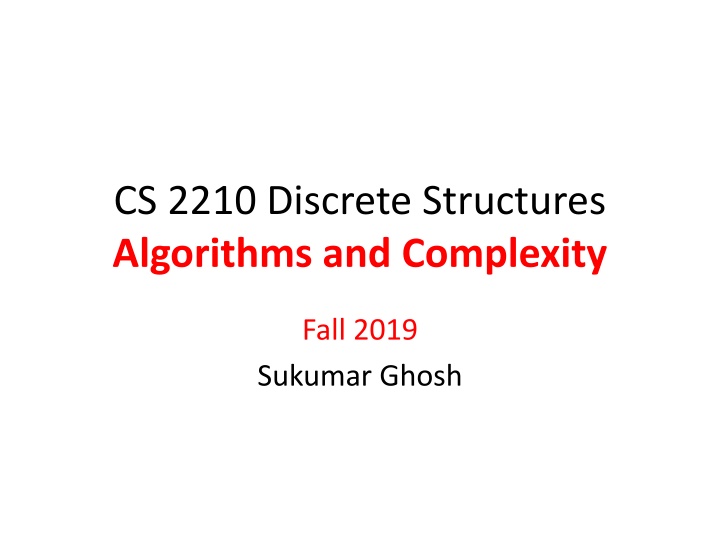
Algorithm Time Complexity and Sorting Techniques
Dive into the world of algorithms with a focus on time complexity analysis and sorting methods like linear search, binary search, and bubble sort. Learn about basic operations, counting procedures, and the efficiency of different algorithms.
Download Presentation

Please find below an Image/Link to download the presentation.
The content on the website is provided AS IS for your information and personal use only. It may not be sold, licensed, or shared on other websites without obtaining consent from the author. If you encounter any issues during the download, it is possible that the publisher has removed the file from their server.
You are allowed to download the files provided on this website for personal or commercial use, subject to the condition that they are used lawfully. All files are the property of their respective owners.
The content on the website is provided AS IS for your information and personal use only. It may not be sold, licensed, or shared on other websites without obtaining consent from the author.
E N D
Presentation Transcript
CS 2210 Discrete Structures Algorithms and Complexity Fall 2019 Sukumar Ghosh
What is an algorithm A finite set (or sequence) of precise instructions for performing a computation. Example: Maxima finding procedure max (a1, a2, , an: integers) max := a1 for i :=2 to n if max < aithen max := ai return max {the largest element}
Flowchart for maxima finding start max := a1 Given n elements, can you count the total number of operations? i: = 2 no max < ai yes i: = i + 1 max = ai no i = n? yes end
Time complexity of algorithms Counts the largest number of basic operations required to execute an algorithm. Example: Maxima finding procedure max (a1, a2, , an: integers) max := a1 for i :=2 to n if max < a1 then max := ai {2 ops + 1 op to check if i > n + 1 op to increment i} return max {the largest element} 1 operation 1 operation i:=2 {n-1 times} The total number of operations is 4(n-1)+2 = 4n-2
Time complexity of algorithms Example of linear search (Search x in a list a1 a2 a3 an) k := 1 while k n do {if x = ak then found else k: = k+1} search failed The maximum number of operations is 3n+2. If we are lucky, then search can end even in the first iteration. {1 op} {n ops k n} {2n ops + 1 op}
Time complexity of algorithms Binary search (Search x in a sorted list a1 <a2 <a3 < <an) { {search failed} How many operations? Roughly log n. Why?
Bubble Sort procedure bubblesort ( A : list of items ) n = length (A) repeat for i = 1 to n-1 do if A[i-1] > A[i] then swap (A[i-1], A[i]) end if end for n: = n - 1 until n=0 end procedure
Bubble Sort 3 2 2 1 1 2 3 1 2 2 4 1 3 3 3 1 4 4 4 4 5 5 5 5 5 [n=5 items are there] n-1 operations n-2 operations n-3 operations 1 (first pass) (second pass) (third pass) (fourth pass) The worst case time complexity is (n-1) + (n-2) + (n-3) + + 1 = n(n-1)/2
The Big-O notation It is a measure of the growth of functions and often used to measure the complexity of algorithms. DEF. Let f and g be functions from the set of integers (or real numbers) to the set of real numbers. Then f is O(g(x)) if there are constants C and k, such that |f(x)| C|g(x)| for all x > k Intuitively, f(x) grows slower than some multiple of g(x) as x grows without bound. Thus O(g(x)) defines an upper bound of f(x).
The Big-O notation y = x2+ 2x + 1 y= 4x2 x2+ 2x + 1 = O(x2) y = x2 4 Since = 4 x2> x2+ 4x + 1 3 whenever x > 1, 4x2defines an upper bound of the growth of x2+ 2x + 1 2 1 1 2 Defines an upper bound of the growth of functions
The Big- (omega) notation DEF. Let f and g be functions from the set of integers (or real numbers) to the set of real numbers. Then f is (g(x)) if there are constants C and k, such that |f(x)| C|g(x)| for all x > k Example. 7x2 + 9x + 4 is (x2), since 7x2+ 9x + 4 1. x2 for all x Thus defines the lower bound of the growth of a function Question. Is 7x2 + 9x + 4 (x)?
The Big-Theta () notation DEF. Let f and g be functions from the set of integers (or real numbers) to the set of real numbers. Then f is (g(x)) if there are constants C1 and C2 a positive real number k, such that C1.|g(x)| |f(x)| C2.|g(x)| for all x > k 7x2 + 9x + 4 is (x2), since 1. x2 7x2+ 9x + 4 8. x2 for all x > 10 Example.
Average case performance EXAMPLE. Compute the average case complexity of the linear search algorithm. a1 a2 a3 a4a5 .. an (Search for x from this list) If x is the 1stelement then it takes 5 steps If x is the 2ndelement then it takes 8 steps If x is the ithelement then it takes (3i + 2) steps So, the average number of steps = 1/n [5+8+ +(3n+2)] = ?
Classification of complexity Complexity Terminology (1) (log n) (log n)c Constant complexity Logarithmic complexity Poly-logarithmic complexity (n) (nc) (bn) (b>1) Linear complexity Polynomial complexity Exponential complexity (n!) Factorial complexity We also use such terms when is replaced by O (big-O)
Exercise Complexity of n5 Complexity of 2n Complexity of log (n!) Complexity of 12+22+32+ +n2 O(2n) O(n5) (n log n) (n3) True or false? True or false? True or false? True or false? Let S = {0, 1, 2, , n}. Think of an algorithm that generates all the subsets of three elements from S, and compute its complexity in big-O notation.
Greedy Algorithms In optimization problems, many algorithms that use the best choice at each step are called greedy algorithms. Example. Devise an algorithm for making change for n cents using quarters, dimes, nickels, and pennies using the least number of total coins?
Greedy Change-making Algorithm Let be the denomination of the coins, (and ) Let the coins be 1, 5, 10, 25 cents. For making 38 cents, you will use for i:= 1 to r while n ci begin 1 quarter 1 dime 3 cents add a coin of value ci to the change n := n- ci The total count is 5, and it is optimum. end Question. Is this optimal? Does it use the least number of coins?
Greedy Change-making Algorithm But if you don t use a nickel, and you make a change for 30 cents using the same algorithm, the you will use 1 quarter and 5 cents (total 6 coins). But the optimum is 3 coins (use 3 dimes!) So, greedy algorithms produce results, but the results may be sub-optimal.
Greedy Routing Algorithm B A C If you need to reach point B from point A in the fewest number of hops, Then which route will you take? If the knowledge is local, then you are tempted to use a greedy algorithm, and reach B in 5 hops, although it is possible to reach B in only two hops.
Other classification of problems Problems that have polynomial worst-case complexity are called tractable. Otherwise they are called intractable. Problems for which no solution exists are known as unsolvable problems (like the halting problem). Otherwise they are called solvable. Many solvable problems are believed to have the property that no polynomial time solution exists for them, but a solution, if known, can be checked in polynomial time. These belong to the class NP (as opposed to the class of tractable problems that belong to class P)
Estimation of complexity Source: D. Harel. Algorithmics: The Spirit of Computing . Addison-Wesley, 2nd edition, 1992
The Halting Problem The Halting problem asks the question. Given a program and an input to the program, determine if the program will eventually stop when it is given that input. Run the program with that input. If the program stops, then we know it stops. But if the program doesn't stop in a reasonable amount of time, then we cannot conclude that it won't stop. Maybe we didn't wait long enough! The question is not decidable in general!
The Traveling Salesman Problem Starting from a node, you have to visit every other node and return To you starting point. Find the shortest route? NP-complete
3-Satisfiability Problem Consider an expression like this: ( 1 2 3) ( 4 5 6) ( ) ( 4 ) ( ) Does there exist an assignment of values of x1, x2, x9 so that this formula is true? NP-Complete problem!



